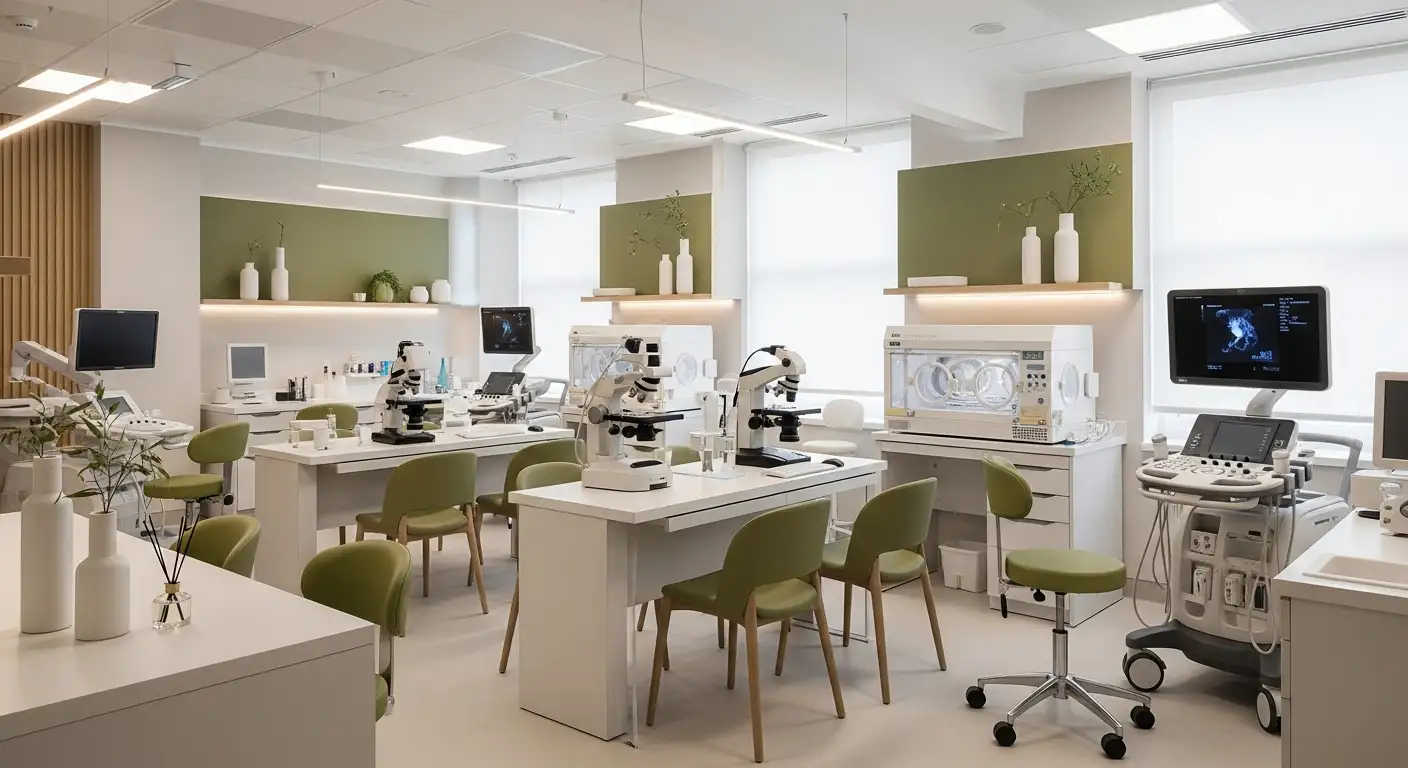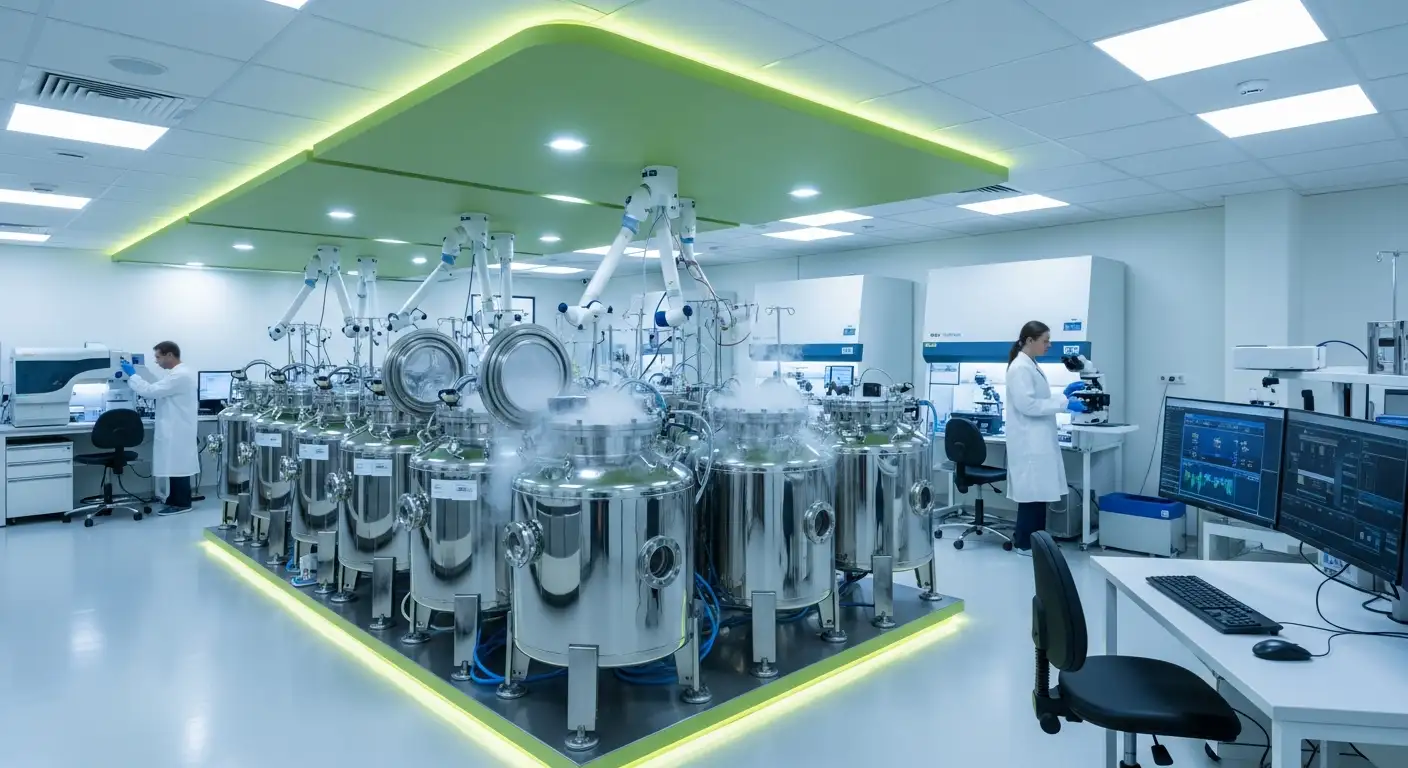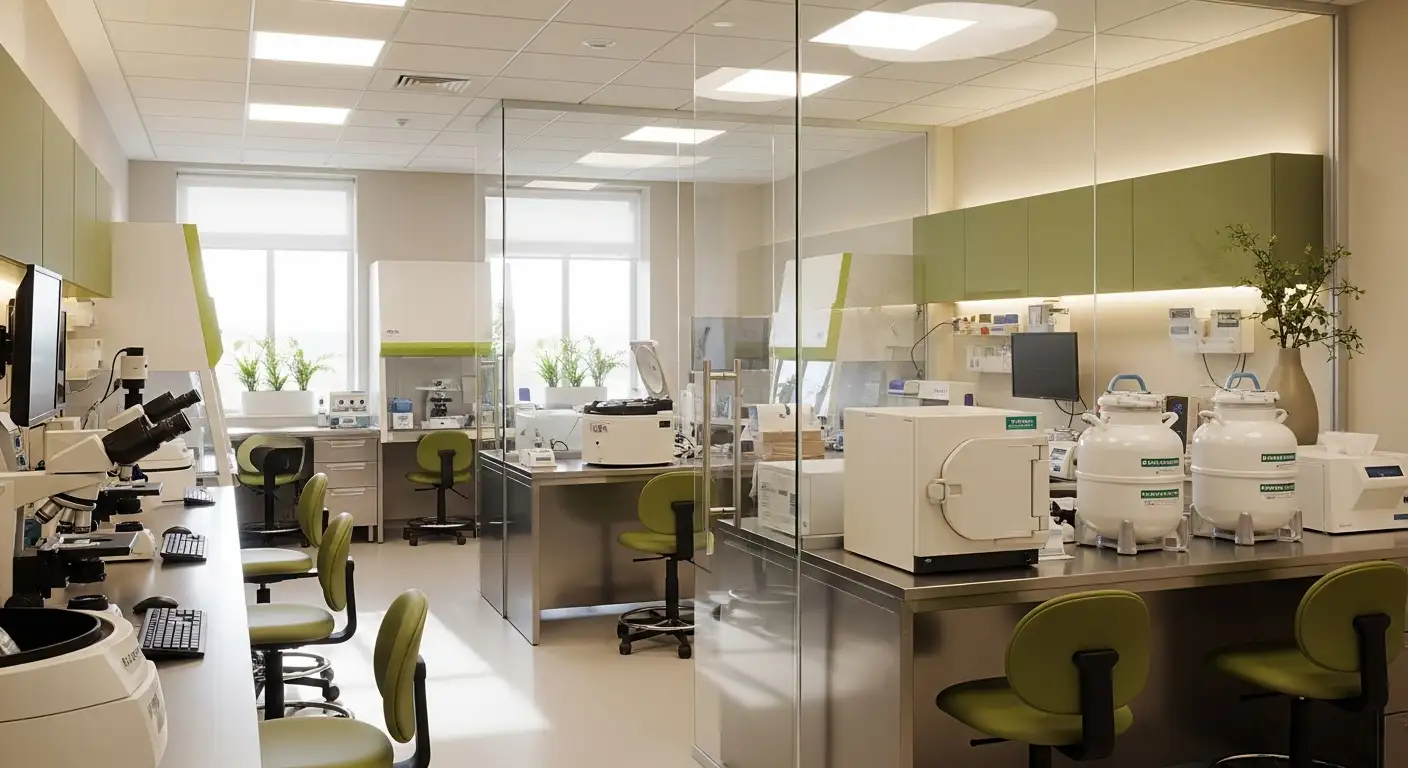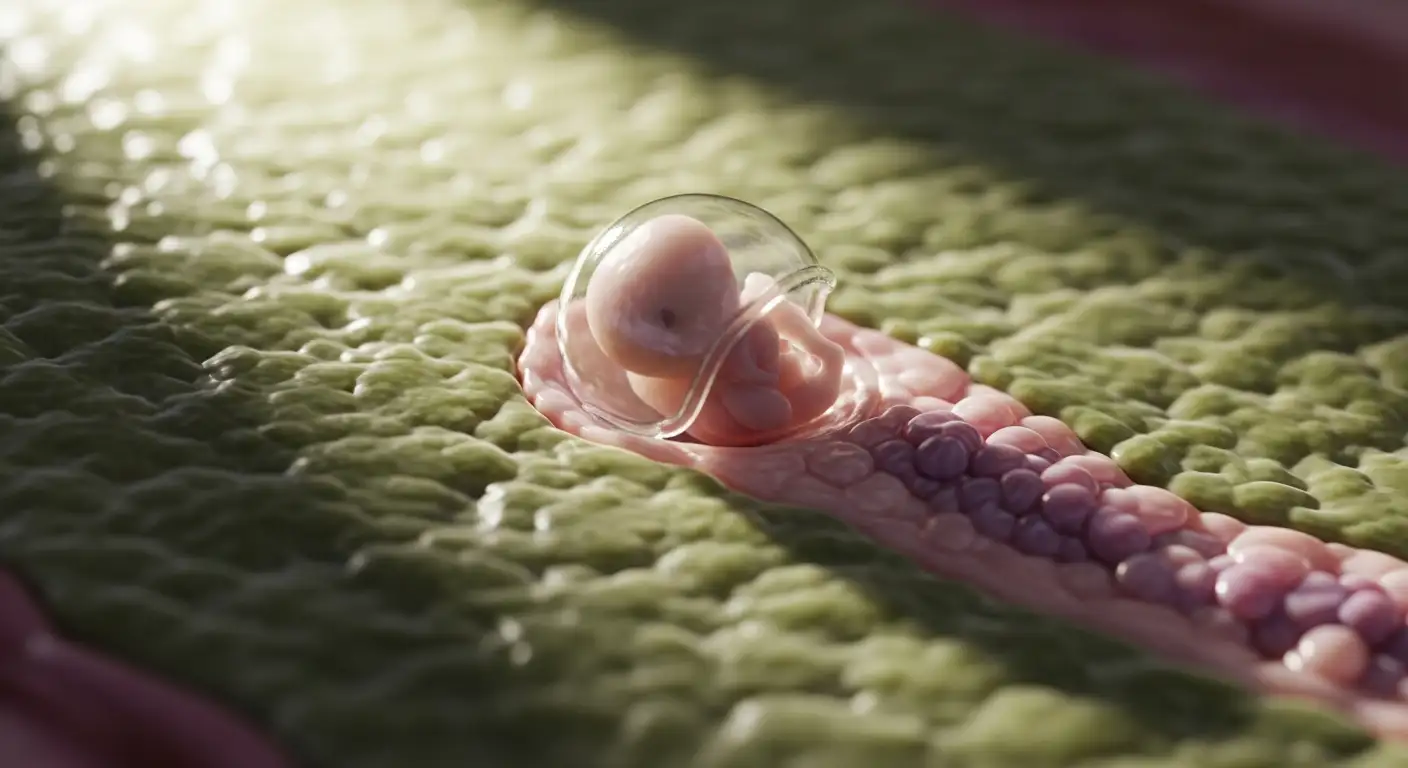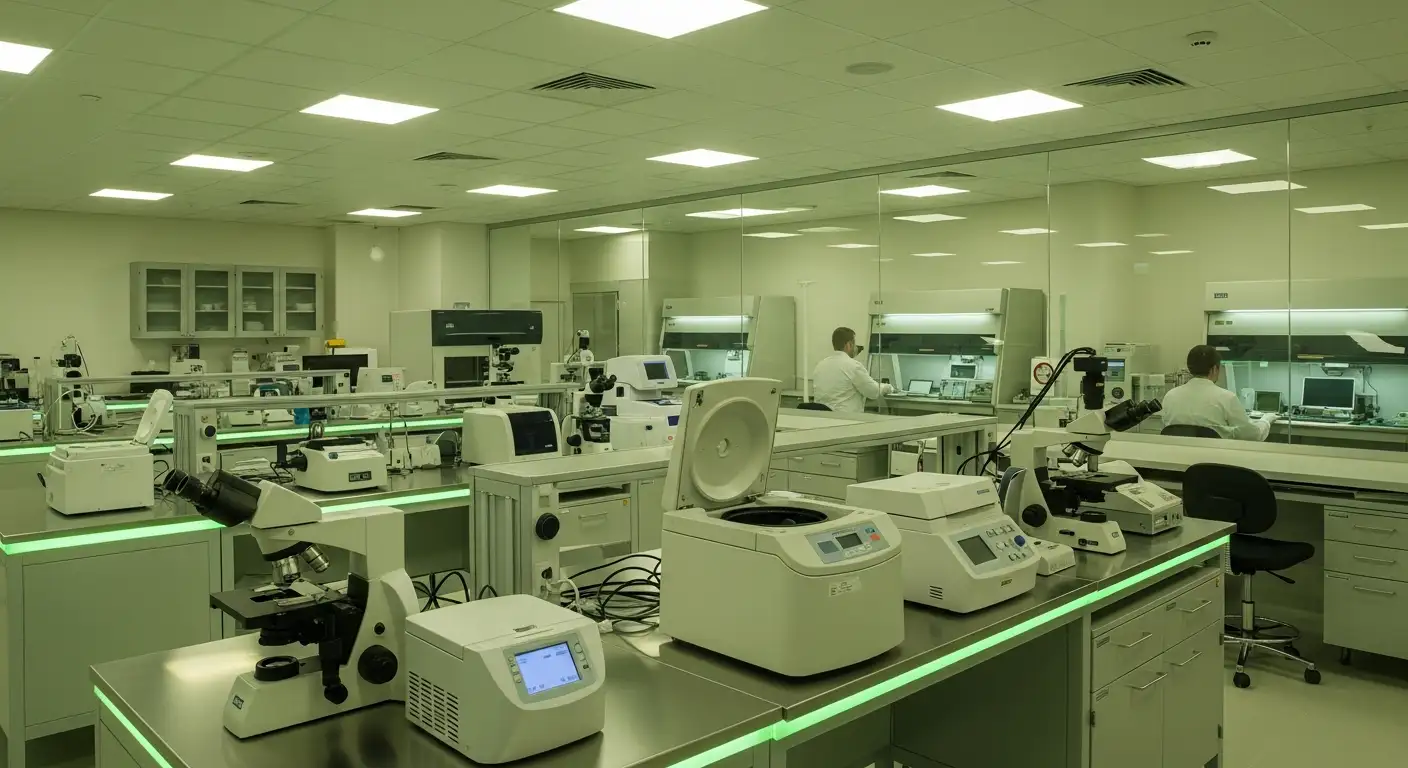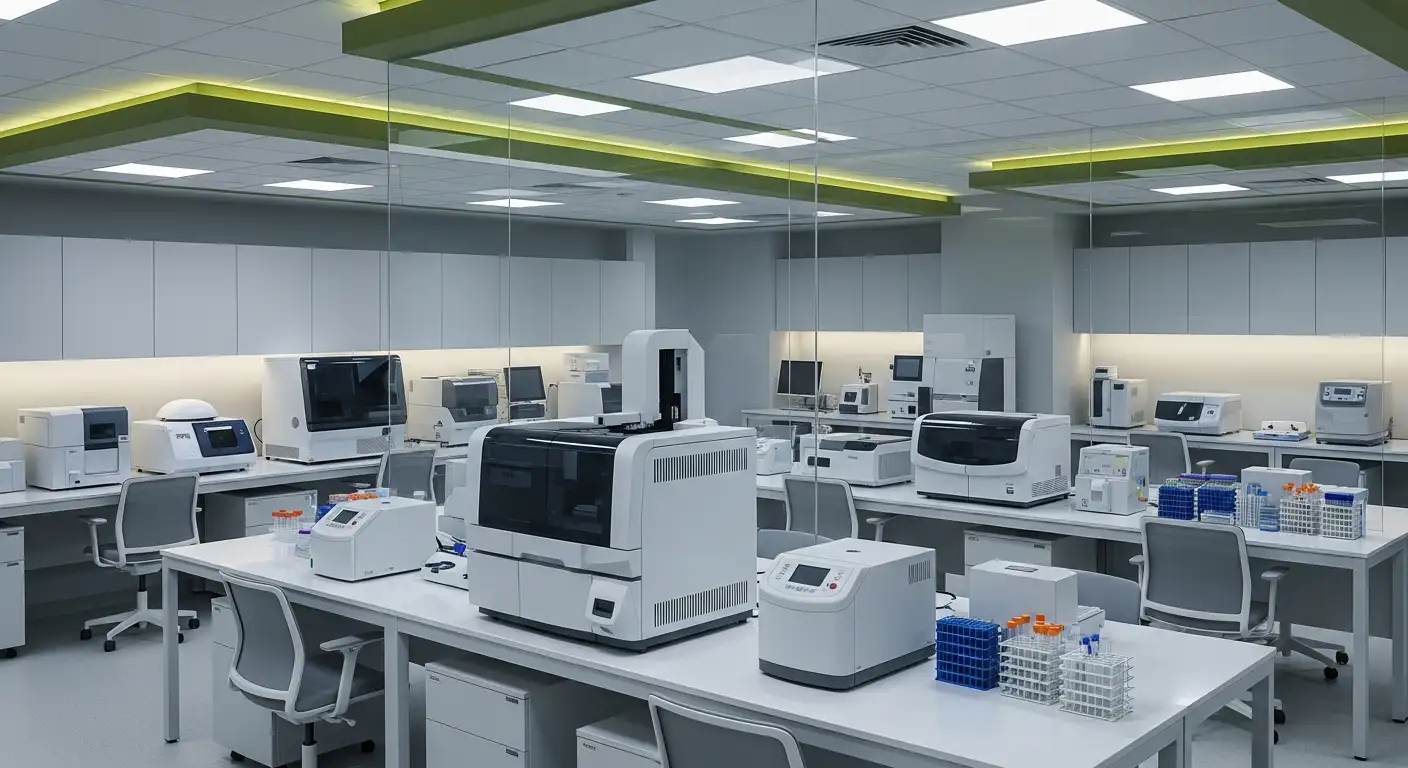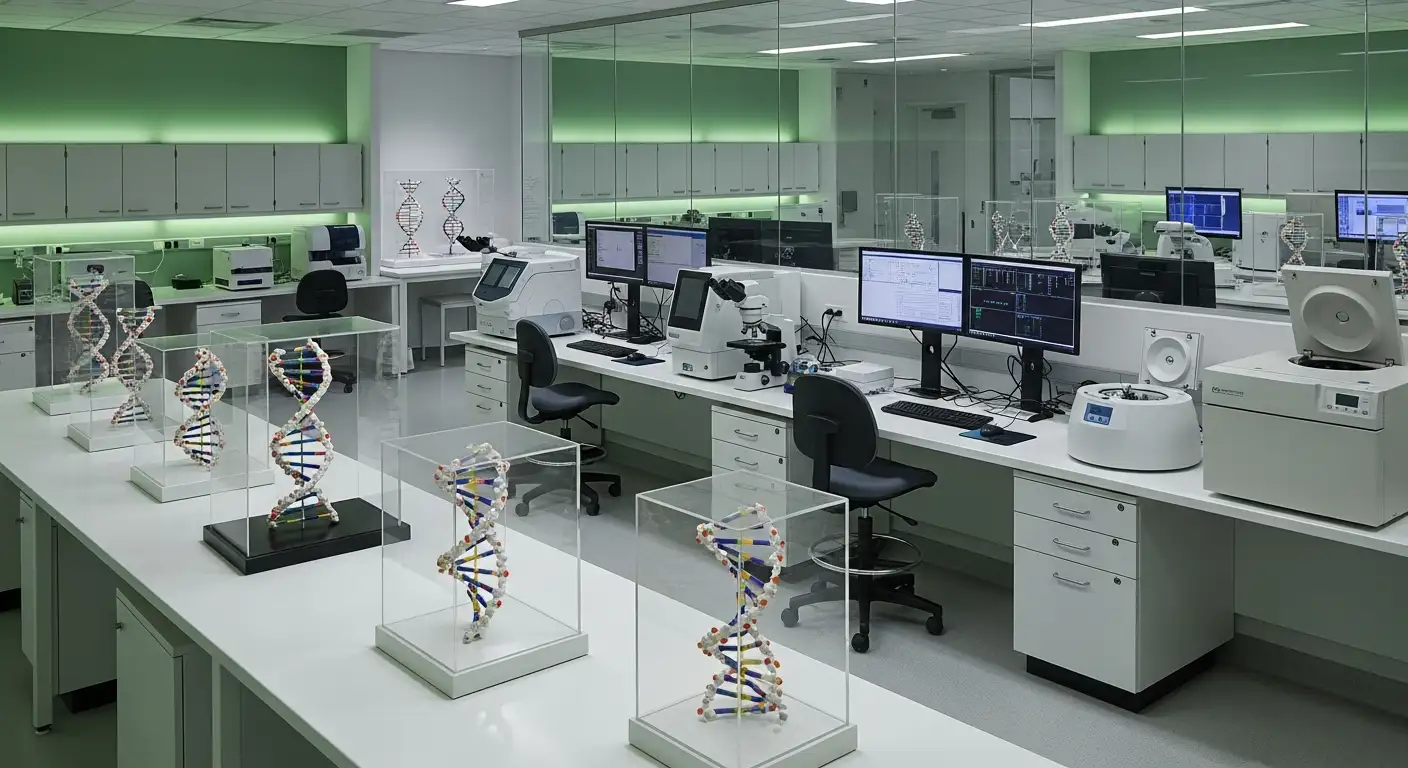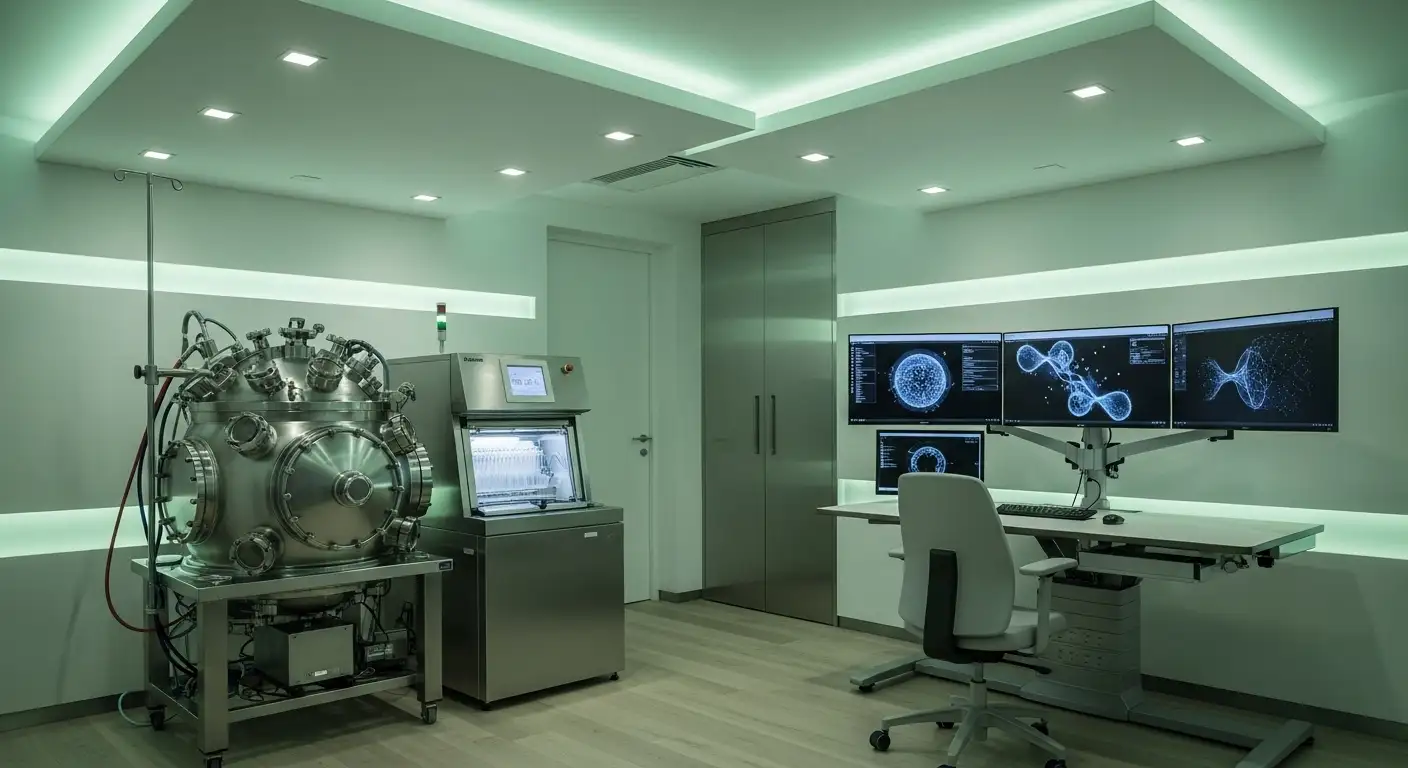Do embryos have a best “day” for transfer?
Unraveling the Optimal Timing for Embryo Transfer in IVF

Understanding Embryo Transfer Timing
The question of when to transfer an embryo during IVF cycles is central to maximizing pregnancy success. While traditional protocols often favored day-3 transfers, recent advances and research indicate that day-5 (blastocyst-stage) transfers may offer certain advantages. This article explores whether embryos have a 'best' day for transfer, considering scientific evidence, embryo development stages, and individual patient factors.
Factors Influencing the Choice of Embryo Transfer Day in IVF
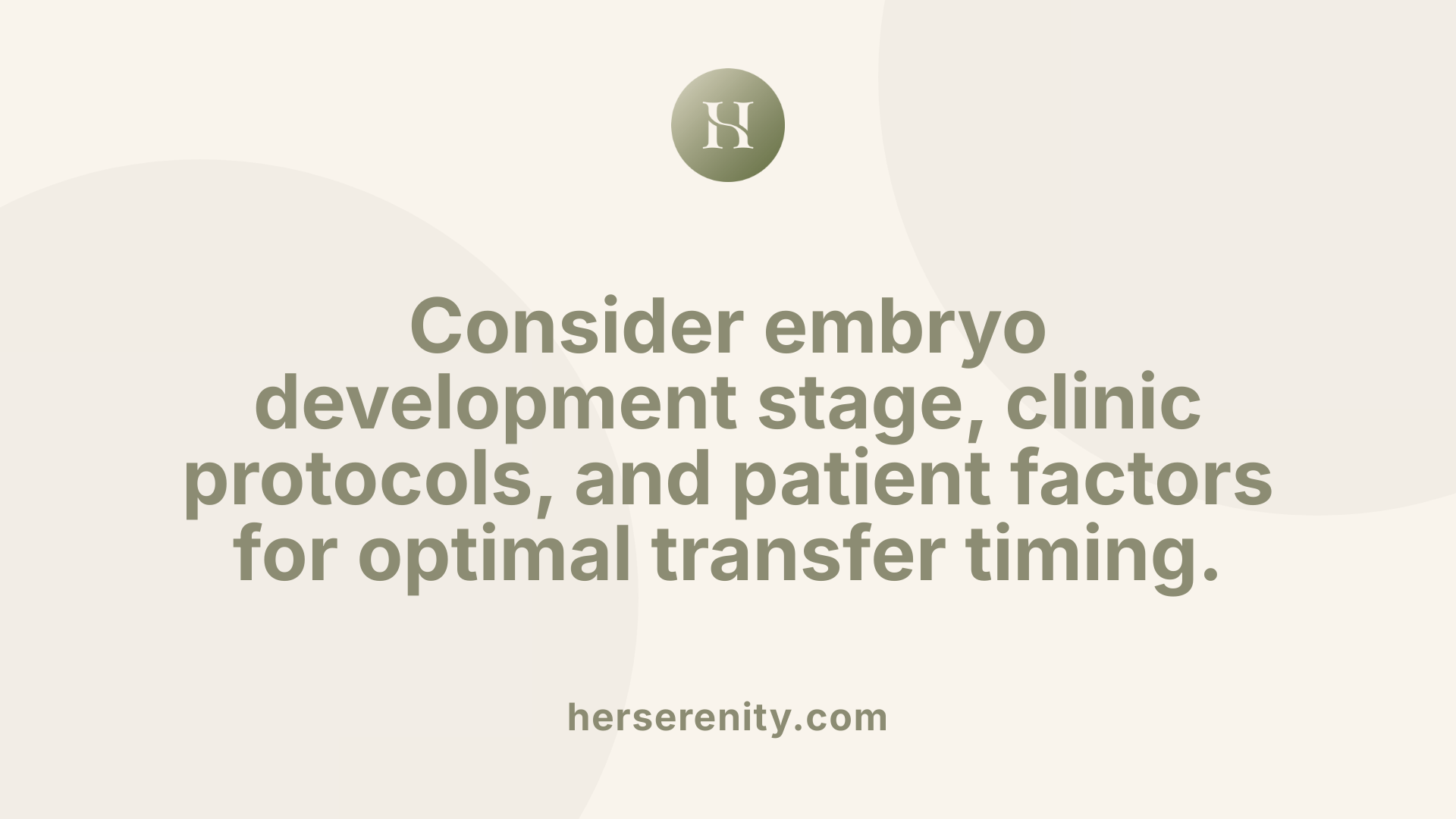
What factors influence the choice of embryo transfer day in IVF procedures?
The decision on whether to perform an embryo transfer at Day 3 or Day 5 in IVF treatments hinges on multiple considerations related to embryo development, clinic protocols, and individual patient factors.
One of the primary influences is the developmental stage of the embryo. Day 3 embryos are at the cleavage stage, typically consisting of 6–8 cells. At this stage, laboratories assess embryo quality based on cell number, symmetry, and the presence of fragments. Conversely, Day 5 embryos, known as blastocysts, have undergone further development, forming a fluid-filled cavity and distinct cell layers, which allows for more detailed evaluation of viability and implantation potential.
Clinic protocols and laboratory capabilities play a significant role as well. Many labs prefer culturing embryos to the blastocyst stage because this enables better selection of the most viable embryos before transfer. Some facilities use frozen embryo transfer (FET) cycles that are scheduled based on embryo development and uterine preparation, providing flexibility in timing.
The type of embryo transfer—whether fresh or frozen—also impacts timing. Frozen embryo transfers generally involve hormonal preparation of the uterine lining after ovarian stimulation, and the timing depends on the days since progesterone support began. Longer culture to Day 5 allows for better embryo assessment and sometimes higher success rates, especially when genetic testing (such as PGT) is performed.
Patient-specific factors include uterine receptivity and overall health status. A receptive uterine environment supports implantation, and medications or lifestyle adjustments may be made to optimize it. Age and embryo quality are critical, with younger women often producing higher-quality embryos suitable for blastocyst transfer.
The expertise of the medical team, including embryologists and reproductive endocrinologists, influences the timing decision. Skilled embryologists evaluate embryo morphology and growth patterns to decide the optimal transfer day.
Ultrasound-guided embryo transfer enhances precision by accurately placing the embryo in the optimal position within the uterus, potentially improving success rates.
Lastly, balancing the number of embryos transferred is essential to reduce the risks of multiple pregnancies. Moving towards single embryo transfer, especially with blastocysts, allows for high success rates while minimizing complications.
| Influencing Factor | Explanation | Additional Details |
|---|---|---|
| Embryo developmental stage | Choice between Day 3 vs. Day 5 transfer | Day 5 gives better selection capacity |
| Laboratory protocols | Use of fresh or frozen transfer cycles | Frozen allows flexibility and testing |
| Embryo quality and development | Assessing embryo viability through morphology and growth | Higher quality, blastocysts preferred for transfer |
| Clinic capabilities and expertise | Laboratory skills and resources | Higher success with experienced teams |
| Uterine receptivity and health | Preparedness of the uterine environment | Medications and lifestyle adjustments |
| Ultrasound guidance | Precision in embryo placement | Increases chances of successful implantation |
| Risks associated with multiple transfer | Strategy to transfer fewer embryos to reduce complications | Moving towards single embryo transfer with blastocysts |
This multifaceted approach ensures that the timing of embryo transfer is optimized to maximize the chance of successful pregnancy, taking into account biological, clinical, and personal factors to tailor treatments for individual patients.
Scientific Basis for Choosing Specific Embryo Transfer Days
What is the scientific basis for choosing a specific day for embryo transfer?
The timing of embryo transfer is based on the embryo’s developmental stage and its likelihood of successful implantation. Early-stage transfers typically occur at day 3, during the cleavage stage, when the embryo has approximately 6-8 cells. In contrast, day 5 transfers involve the blastocyst stage, which has developed for five days post-fertilization and contains around 70-100 cells.
Transferring at the blastocyst stage provides several advantages. It allows embryologists to evaluate the embryo’s quality more accurately, selecting only the most viable for transfer. This stage also aligns better with the uterine lining’s receptivity, potentially increasing the chances of successful implantation.
Clinical guidelines encourage the use of day 5 (blastocyst) transfers when feasible, as they are associated with higher implantation and live birth rates. This is especially true when combined with preimplantation genetic testing (PGT), which can identify chromosomally normal embryos for transfer.
Patient-specific factors often influence the decision. These considerations include the number of fertilized eggs, embryo quality, woman's age, and overall prognosis. While fresh transfers are scheduled based on embryo development, frozen embryo transfers (FETs) can be timed to optimize endometrial receptivity, with success rates comparable to fresh transfers.
In summary, choosing the optimal day for embryo transfer is a strategic decision rooted in embryological science, aimed at maximizing pregnancy chances while minimizing risks such as multiple pregnancies. It carefully balances embryo viability, uterine synchronization, and patient circumstances.
Embryo developmental stages and their significance
The embryo’s development stage at transfer significantly influences IVF success rates. Day 3 embryos are at the cleavage stage, while Day 5 embryos are at the blastocyst stage, which exhibits advanced development, cellular organization, and higher implantation potential.
Impact of embryo morphology and viability assessments
Embryologists assess embryo quality based on shape, cell division rate, and other morphological features. Higher-quality embryos are more likely to implant successfully. Blastocyst evaluation includes the appearance of inner cell mass and trophectoderm layers, which are indicators of viability.
Benefits of blastocyst transfer regarding implantation success
Transfer of blastocysts often results in higher pregnancy rates per embryo transferred. The extended culture period acts as a natural selection process, favoring embryos with better developmental potential.
Genetic testing capabilities at different stages
Day 5 embryos are more amenable to biopsies for genetic testing, such as PGT-A. This process helps identify chromosomal abnormalities, increasing the chance of healthy pregnancies.
Clinical guidelines advocating day 5 over day 3 in certain cases
Many fertility clinics now prefer blastocyst transfer (day 5) because it allows for better embryo selection and reduces the chance of multiple pregnancies by enabling the transfer of fewer embryos.
Research comparing success rates of different transfer days
Multiple studies indicate comparable success rates between day 3 and day 5 transfers in some cases. However, Day 5 transfer generally results in higher implantation and live birth rates, particularly when high-quality blastocysts are available.
Synchronization with uterine receptivity
Waiting until day 5 to transfer the embryo allows better synchronization with the natural window of uterine receptivity, increasing the likelihood of successful implantation.
| Aspect | Day 3 Transfer | Day 5 Transfer | Additional Details |
|---|---|---|---|
| Embryo stage | Cleavage stage | Blastocyst | Advanced cell differentiation |
| Embryo quality assessment | Morphology | Morphology + genetic testing | Better evaluation at day 5 |
| Success rates | Similar or slightly lower | Higher due to selectivity | When viable embryos are available |
| Genetic testing | Less common | More common | Less invasive at day 5 |
| Risk of multiples | Higher if more embryos transferred | Lower with single embryo transfer | Enables fewer embryos |
| Timing | Usually scheduled on day 3 or 5 | Usually scheduled on day 5 | Depends on embryo development |
Ultimately, the decision on when to transfer depends on multiple factors, including embryo quality, patient circumstances, and laboratory techniques. Employing the latest scientific insights and guidelines helps optimize IVF success, making embryo development stage a crucial consideration in treatment planning.
Success Rates and Outcomes: Day 3 vs. Day 5 Embryo Transfer
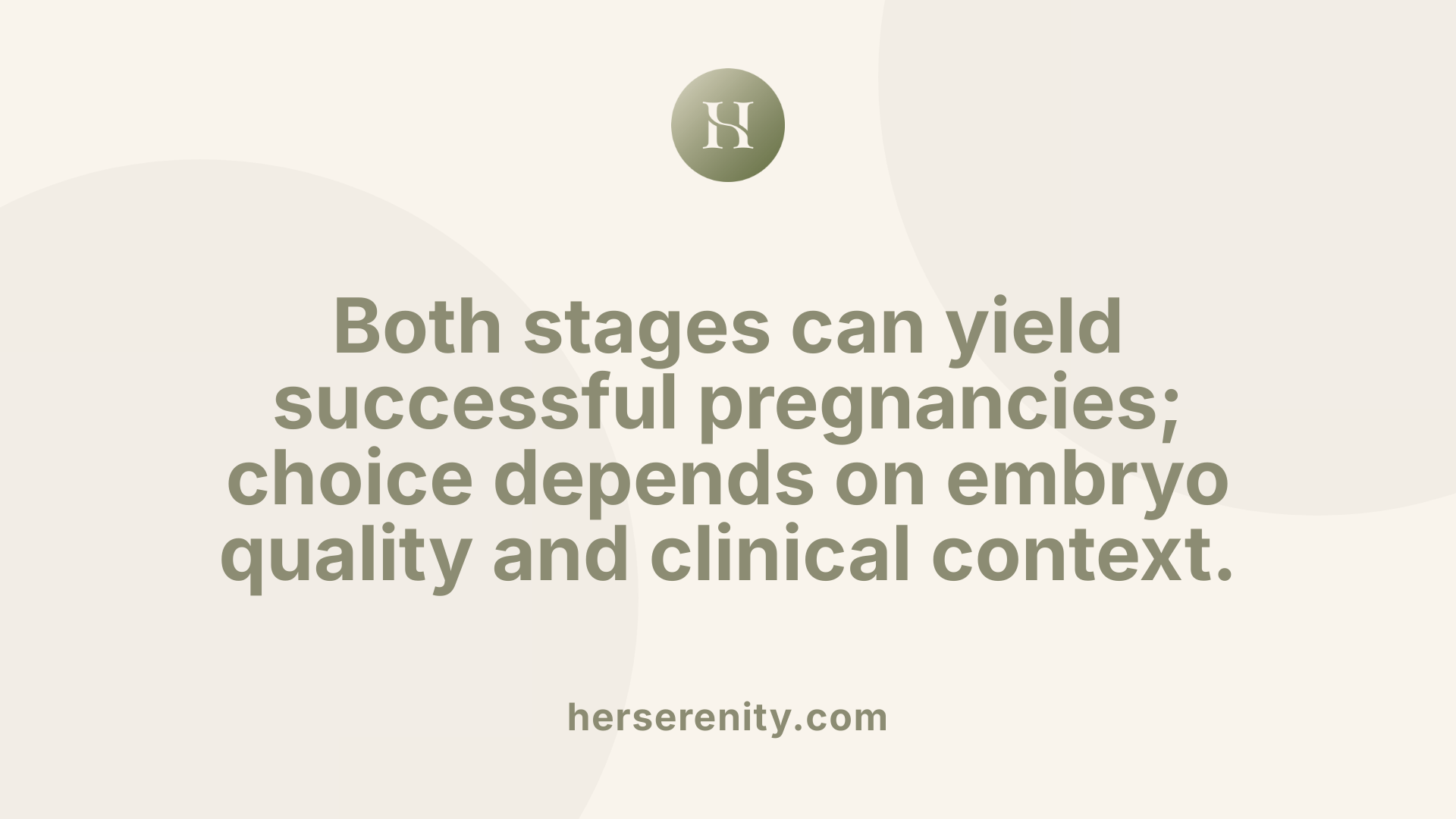
What are the differences between day 3 and day 5 embryo transfers in terms of success rates and outcomes?
Embryo transfer timing plays a significant role in assisted reproductive treatments. Day 3 embryo transfer involves placing embryos into the uterus at the cleavage stage, typically three days after fertilization. These embryos usually have 6 to 8 cells and are transferred early in development. In contrast, Day 5 transfers occur at the blastocyst stage, around five days after fertilization, when the embryo has developed into a structure with multiple cell layers and about 70-100 cells.
Scientific studies comparing these two methods show that success rates—covering pregnancy, implantation, live birth, and multiple pregnancies—are generally similar. Large-scale research concludes that there is no clear advantage of one over the other in these outcomes. However, there are notable differences in the way each approach impacts embryo selection and implantation success.
Day 5 blastocyst transfers tend to have higher implantation rates. This is because embryos at this stage are more developed, allowing embryologists to better assess their quality and viability before transfer. The extended culture period to day 5 also enables more accurate genetic testing, which can identify chromosomal abnormalities. Such testing helps select the most viable embryos, potentially increasing the chances of successful pregnancy.
Furthermore, transferring embryos at the blastocyst stage supports the practice of single embryo transfer (eSET). Because blastocysts are stronger and more viable, clinics often transfer fewer embryos, reducing the risk of multiple pregnancies—a common concern in fertility treatments.
The decision between day 3 and day 5 transfer depends on various factors such as embryo quality, the number of fertilized eggs, and individual patient circumstances. Some clinics prefer day 5 transfers because they offer more detailed embryo assessment and better synchronization with the uterine lining.
Ultimately, both options are backed by scientific evidence, and the choice usually hinges on specific medical and embryological considerations. Patients and clinicians work together to determine the most suitable timing to optimize chances of success based on their unique situation.
Recent advances and ongoing research continue to refine these practices, but current data show that both approaches provide comparable success in achieving pregnancy, with each offering specific advantages depending on the clinical context.
Benefits and Drawbacks of Embryo Transfer Stages
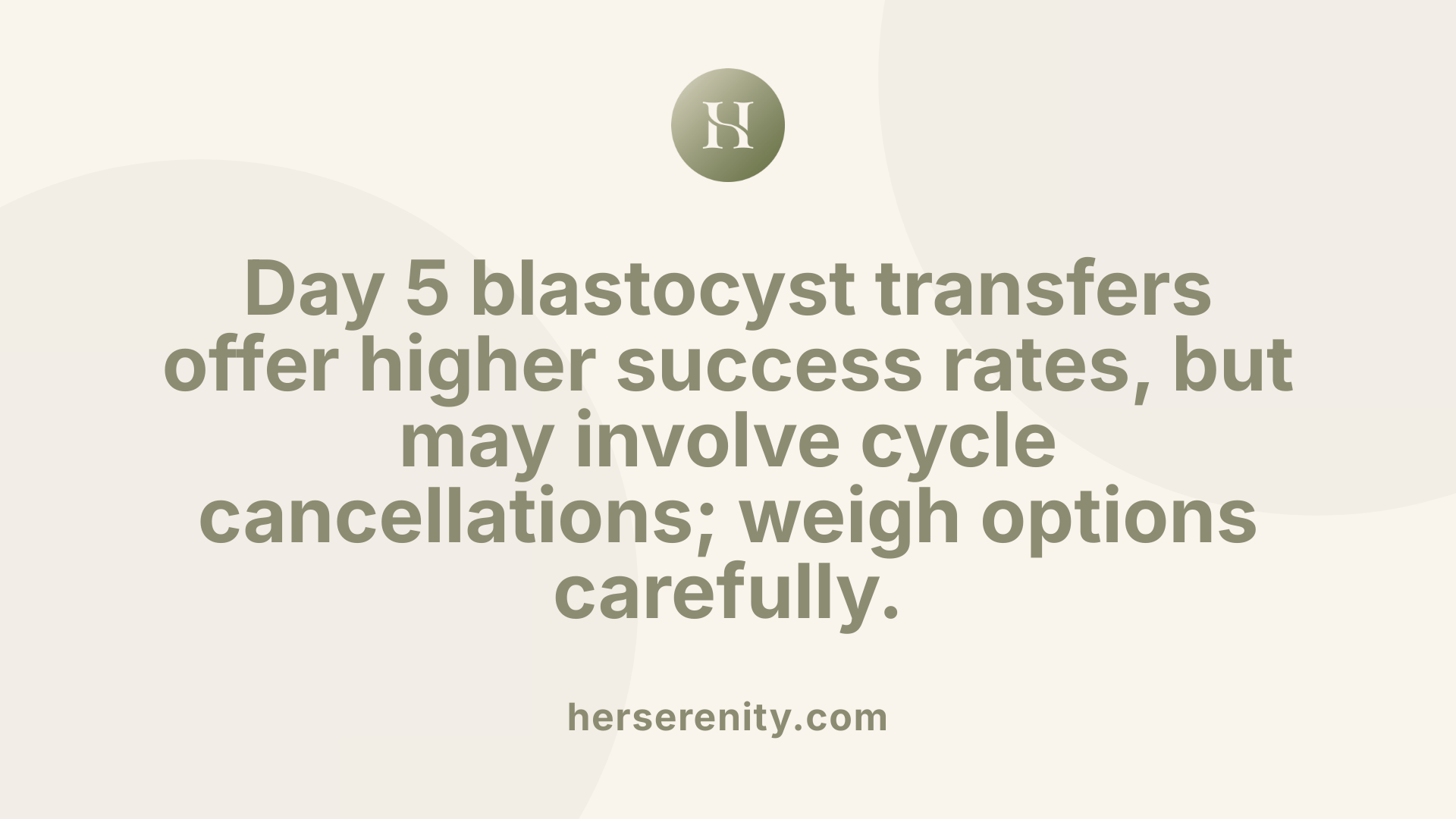
What are the benefits and drawbacks of transferring embryos at different stages, such as the blastocyst stage?
Transferring embryos at different developmental stages—mainly Day 3 (cleavage stage) and Day 5 (blastocyst stage)—each comes with unique advantages and potential challenges.
Day 3 embryo transfer involves placing fertilized eggs at an earlier point, typically when they have about 6 to 8 cells. This stage offers the benefit of higher embryo availability because more embryos are usually available at this point. It is often preferred if only a limited number of embryos are created or when patients have fewer fertilized eggs. Furthermore, it allows for the possibility of cryopreservation (freezing) more embryos for future cycles.
However, Day 3 transfers generally have lower success rates in terms of implantation and live birth compared to blastocyst transfers. Because the embryos are less developed, it can be more challenging to assess their viability, leading to a higher chance of cycle cancellation if embryos do not develop well.
In contrast, Day 5 embryo transfer involves placing the embryo at the blastocyst stage, typically when it contains about 70-100 cells with distinct cell layers. This advanced development stage offers higher chances of successful implantation and pregnancy because the embryo's quality can be more thoroughly evaluated based on its growth and morphology. Transferring at this stage also better synchronizes with the uterine lining, increasing the likelihood of successful implantation.
The main drawback of blastocyst transfer is that fewer embryos survive to this stage, which may reduce the total number of embryos available for transfer or freezing. Extended culture can also lead to cycle cancellations if embryos do not reach the blastocyst stage, especially with poorer-quality eggs or in older patients.
Furthermore, not all clinics favor blastocyst transfer for every patient. Decisions are often tailored based on embryo quality, patient age, and specific clinical circumstances.
In essence, selecting the optimal timing involves balancing the potential for higher success rates with the risk of fewer embryos surviving to blastocyst stage and the possibility of cycle cancellation.
How does the stage of embryo transfer affect success rates and patient outcomes?
Research indicates that, generally, blastocyst-stage transfers (Day 5) are associated with higher implantation and live birth rates compared to Day 3 transfers. This benefit is partly because blastocysts can be more accurately selected for viability, often resulting in fewer embryos transferred and a reduced risk of multiple pregnancies.
Studies show success rates for both stages are comparable per cycle; however, the ability to better evaluate embryo quality at the blastocyst stage often leads to improved pregnancy outcomes, especially when combined with genetic testing techniques like PGT.
What about the risks related to cycle cancellation and embryo availability?
Extended embryo culture to Day 5 carries the risk of cycle cancellation if embryos do not develop adequately. This is a significant consideration, especially for patients with a limited number of fertilized eggs or lower-quality embryos, common in older women.
Cycle cancellation not only impacts the emotional and financial aspects but also influences treatment planning. Clinics often weigh the likelihood of successful blastocyst development against these risks when devising IVF protocols.
How does stage selection impact embryo freezing and future options?
Embryos reaching the blastocyst stage tend to survive freezing and thawing better than earlier-stage embryos. This improves their viability for future transfers.
Moreover, blastocyst transfers facilitate genetic testing, which can identify chromosomal abnormalities, further improving the chances of a healthy pregnancy.
What is the influence on multiple pregnancy risk?
Fewer embryos typically need to be transferred at the blastocyst stage because of higher implantation success. This allows many clinics to adopt single embryo transfer protocols, significantly reducing the risk of multiple pregnancies, which are associated with preterm birth and other complications.
| Embryo Transfer Stage | Advantages | Disadvantages | Common Use Cases |
|---|---|---|---|
| Day 3 (Cleavage) | More embryos available for transfer and freezing; lower risk of cycle cancellation | Lower success rates; poorer embryo quality assessment | Patients with few fertilized eggs or initial assessment for early transfer |
| Day 5 (Blastocyst) | Higher success rates; better embryo selection; allows for genetic testing; lower multiple pregnancy risk | Fewer embryos surviving to this stage; risk of cycle cancellation | Patients with good-quality embryos and sufficient fertilization |
The choice between Day 3 and Day 5 embryo transfer depends largely on individual patient circumstances, embryo quality, and clinical goals. Both approaches are scientifically supported, with the trend favoring blastocyst-stage transfer for its potential to improve pregnancy outcomes and reduce multiple pregnancies.
Is There a Universally 'Best' Day for Embryo Transfer?

Is there a universally 'best' day for embryo transfer?
The question of whether there is a singular optimal day for embryo transfer does not have a straightforward answer. Instead, the timing largely depends on individual circumstances, including embryo quality, the patient’s health, and specific clinical protocols at the fertility clinic.
Historically, embryo transfers were commonly performed on day 3 after fertilization, during the cleavage stage when the embryo has around 6 to 8 cells. However, recent advances in embryology have shifted practice toward transferring at the blastocyst stage, typically on day 5. Blastocysts are more developed, with approximately 70-100 cells, and are considered to offer higher chances of successful implantation.
Research shows that transferring embryos at the blastocyst stage often results in higher pregnancy and live birth rates. This is because blastocysts provide better insights into embryo viability and allow for more precise selection through genetic testing. The ability to identify the strongest embryo reduces the number of embryos transferred, which also diminishes the risk of multiple pregnancies.
Despite these advantages, not all embryos reach the blastocyst stage, especially in cases involving fewer or less viable embryos. For some patients, particularly those with fewer fertilized eggs or poorer embryo quality, a day-3 transfer might be the more appropriate option.
Personalized decision-making
Given the varying factors involved, clinical decisions about the embryo transfer day are highly personalized. The embryology team, in collaboration with the reproductive endocrinologist, evaluates embryo development, quality, and patient-specific factors to determine the most suitable timing.
Some patients may benefit from transferring earlier if their embryos do not progress well to the blastocyst stage. Conversely, patients with high-quality embryos that have developed successfully to day 5 or beyond are often recommended to wait for the blastocyst stage. This strategy can optimize outcomes and reduce the number of embryos needed for transfer.
Limitations of universal rules
While scientific data supports the use of blastocyst transfers in many contexts, there is no one-size-fits-all rule. Factors such as the patient's age, previous IVF outcomes, and embryo quality influence the decision. Some clinics advocate for day-3 transfers in specific cases, such as when embryo culture technology or resources are limited.
Furthermore, waiting until day 5 is not always feasible if embryo development is slow or compromised. The decision must consider each patient’s unique situation, emphasizing the importance of expert guidance and personalized treatment planning.
Influence of embryo quality and patient factors
Embryo quality is a crucial determinant in choosing the transfer day. Higher-quality blastocysts are more likely to implant successfully owing to their advanced development and better synchronization with the uterine lining.
Additionally, patient-related factors, such as age, ovarian reserve, and previous IVF history, play a role in the decision-making process. For example, older women may produce fewer high-quality embryos, which can influence whether a day-3 or day-5 transfer is more appropriate.
Ultimately, the best approach involves a thorough assessment of embryo development, patient health, and clinic capabilities, making the timing a tailored decision rather than a universal rule.
| Aspect | Day 3 Transfer | Day 5 Transfer | Additional Notes |
|---|---|---|---|
| Embryo Stage | Cleavage stage | Blastocyst | Advanced development allows better selection |
| Success Rates | Comparable in some cases | Often higher, especially with high-quality embryos | depends on embryo quality and patient factors |
| Embryo Evaluation | Limited | More detailed | Genetic testing more feasible at Day 5 |
| Embryo Choice | Based on early appearance | Based on development and testing | Better selection can reduce multiple pregnancies |
| Suitability | Fewer embryos or slow development | When good quality blastocysts are available | Follows individual embryo progression |
In conclusion, the decision about whether to transfer on day 3 or day 5 should be personalized. Both options are scientifically supported, but the optimal choice depends on embryo quality, patient characteristics, and laboratory resources. Collaborating with the fertility team ensures the best possible outcome tailored to each individual.
Preparation and Procedure of Embryo Transfer

How is the timing of embryo transfer determined in relation to hormonal support and embryo development?
The scheduling of embryo transfer is a carefully coordinated decision that hinges on both the embryo's growth stage and hormonal preparations. In cases of frozen embryo transfer (FET), hormonal medication routines are initiated to ready the uterine lining. This typically involves administering estrogen to build the endometrial tissue, followed by progesterone to support its receptivity.
The specific day for transfer depends on the embryo's development stage—either at day 3 (cleavage stage) or day 5 (blastocyst stage)—and the start of progesterone support. For a five-day (blastocyst) embryo, the transfer generally occurs on the sixth day after beginning progesterone therapy. This timing ensures that the window of implantation aligns optimally with the embryo's development.
Embryologists assess embryo quality and developmental progress before finalizing the transfer schedule. They consider factors such as embryo morphology and cell division rates to select the best embryo for transfer. The medical team collaborates closely with the patient to determine the most suitable timing, aiming to synchronize the embryo's arrival in the uterus with the period of endometrial receptivity.
This synchronization maximizes the chance of successful implantation and pregnancy. Precise scheduling also helps reduce the risk of cycle cancellation due to mistimed embryo development or suboptimal uterine conditions, ultimately improving assisted reproduction success rates.
Patient Experience and Post-Transfer Care
What are the recommended practices after embryo transfer?
After undergoing embryo transfer, patients are generally advised to follow specific practices to optimize their chances of a successful pregnancy. One of the most important is resting and avoiding strenuous activities. While some clinics do not require complete bed rest, it is common to recommend a period of light activity and minimal stress to support implantation.
Most healthcare providers suggest a waiting period of about two weeks before performing a pregnancy test. This timeframe allows the embryo to implant properly and provides a clearer indication of pregnancy status. During this time, patients are often asked to continue any hormonal medications prescribed by their doctor, such as estrogen and progesterone, to help maintain the uterine lining and support early pregnancy development.
In addition, psychological well-being plays a significant role in post-transfer care. Patients are encouraged to manage stress, seek emotional support from partners, family, or counselors, and maintain a positive outlook. This support can help mitigate anxiety and improve overall experience during the critical waiting period.
Preparation routines before transfer
Preparation for embryo transfer includes medication routines, which may involve hormone therapies to prime the uterine lining for implantation. Patients are also advised to avoid certain chemicals, extreme temperatures, and activities that could negatively impact their health or embryo viability.
Lifestyle adjustments before the procedure include ensuring adequate rest, staying well-hydrated, and following a balanced diet. Some clinics recommend avoiding heavy physical exertion or stressful situations in the days leading up to the transfer.
Timeline to pregnancy testing
Following embryo transfer, the typical waiting period for pregnancy testing is approximately two weeks. During this interval, patients are monitored for any signs of early pregnancy and are often advised to avoid pregnancy-related stress or strenuous activities.
Depending on the clinic’s protocol and whether hormonal support continues, some patients may have blood tests (beta-hCG tests) to detect pregnancy hormone levels sooner, while others wait for a urine test from home or at the clinic.
Psychological considerations and support
Waiting for pregnancy test results can be an emotionally challenging time for many patients. Feelings of hope, anxiety, and uncertainty are common.
To help manage these emotions, patients are encouraged to seek support from mental health professionals, support groups, or loved ones. Many fertility clinics also offer counseling services or support networks to help patients cope with the stress.
Building a positive mental attitude and engaging in relaxing activities can also be beneficial during this crucial period. Clear communication with the healthcare team about concerns and expectations is essential to foster reassurance and emotional resilience.
| Aspect | Recommendations | Additional Notes |
|---|---|---|
| Rest & Activity | Light activity, avoid strenuous exertion | No strict bed rest necessary, focus on comfort |
| Hormonal Support | Continue prescribed estrogen & progesterone | Support lining and early pregnancy |
| Timeline | About two weeks to pregnancy test | Blood or urine testing depending on protocol |
| Emotional Support | Counseling, support groups, relaxation techniques | Reduce anxiety and manage expectations |
| Lifestyle | Hydration, balanced diet, avoiding harmful substances | Optimize overall health for pregnancy |
This comprehensive approach to post-transfer care underscores the importance of physical, emotional, and medical support for maximizing IVF success.
Balancing Embryo Selection and Uterine Synchronization
Using embryo grading for selection
Embryo grading is a vital step in assisted reproduction, helping determine which embryo is most likely to result in a successful pregnancy. Embryologists evaluate embryos based on several criteria, including the number of cells, the rate of cell division, symmetry, and the presence of fragments. High-quality embryos with optimal grading are more likely to implant successfully.
This grading directly influences the decision on the day of transfer. If a good-quality embryo reaches the blastocyst stage (day 5), it is often favored for transfer because of its proven higher likelihood of successful implantation. Conversely, if fewer embryos are available or if they do not meet the quality criteria, embryo transfer may be scheduled at an earlier stage, such as day 3.
Fertility clinic practices in embryo selection
Most clinics aim to maximize success rates by transferring the best embryo available. When embryos reach the blastocyst stage, the developmental assessment allows for better selection, which improves the chances of pregnancy and reduces the risk of multiple pregnancies. Clinics routinely culture embryos to day 5 when feasible because of these advantages.
In cases where only a few good-quality blastocysts are present, embryo freezing becomes an option to preserve these for future cycles. This approach, known as frozen embryo transfer (FET), takes advantage of improved success rates and allows for better timing with the recipient's cycle.
Impact of multiple embryo transfer on pregnancy risks
Transferring multiple embryos can increase the probability of pregnancy per cycle but also raises the risk of multiple pregnancies—twins, triplets, or more. Multiple pregnancies carry higher risks of preterm birth, low birth weight, and other complications.
Therefore, many clinics now prefer single embryo transfer (SET), especially when a high-quality embryo is available. SET reduces the likelihood of multiple pregnancies significantly while maintaining good overall success rates, particularly when the embryo is at the blastocyst stage.
Single embryo transfer as a strategy
Single embryo transfer (eSET) is increasingly common, as it balances the desire for a successful pregnancy with the need to minimize health risks for both mother and baby. When a high-quality blastocyst is identified, transferring just one embryo often leads to comparable pregnancy outcomes with fewer complications.
The decision to opt for eSET depends on multiple factors, including embryo quality, patient age, and previous IVF success. The goal is always to select the strongest embryo for transfer, which maximizes the chance of implantation while lowering the risk of multiple gestations.
Embryo assessment and transfer timing
The process of embryo selection is deeply tied to the developmental stage and quality. Embryos are assessed regularly, and their grading guides whether the transfer is performed at day 3 (cleavage stage) or day 5 (blastocyst stage). Although both strategies can be successful, recent trends favor day 5 transfer for higher accuracy in embryo selection.
Waiting until day 5 enables embryologists to observe the embryo's ongoing development and discard those with poor progression, thereby increasing the likelihood that only the most viable embryo is transferred.
| Embryo Stage | Typical Cell Count | Selection Benefits | Risks and Limitations |
|---|---|---|---|
| Day 3 (Cleavage) | 6–8 cells | Suitable for fewer fertilized eggs; earlier transfer | Less developmental information available; potential for transfer of less viable embryos |
| Day 5 (Blastocyst) | 70–100 cells | Better embryo viability assessment, higher implantation rates | Requires high-quality embryos to reach this stage; possible embryo loss if development stalls |
Understanding the balance between selecting high-quality embryos and timing the transfer optimally helps improve overall IVF success. The choice depends on individual clinical circumstances, the number of embryos, and laboratory capabilities.
Final Thoughts on Embryo Transfer Timing
While scientific and clinical evidence supports the benefits of blastocyst-stage (day 5) transfers, especially in terms of embryo selection and higher implantation rates, the decision about when to transfer should always be personalized. Factors such as embryo quality, patient health, cycle type, and laboratory capabilities influence the optimal timing. No single day is universally best; instead, a tailored approach, supported by a skilled fertility team and thorough evaluation, offers the best chance for successful pregnancy. Ultimately, advancements in embryo culture and genetic testing continue to refine our understanding, informing decisions that improve outcomes for individual patients.
References
- Day-3 vs. Day-5 fresh embryo transfer - PMC
- IVF Embryo Transfers: The Complete Guide 2025
- Embryo Transfer Day 101: Everything You Need to Know
- Does Waiting Until Day 5 For Embryo Transfer Affect IVF ...
- Day 3 V.s. Day 5 Embryo Transfer
- What Are the Benefits of a Day 5 Embryo Transfer?
- Which cycle day is a frozen embryo transfer?
- Decisions to make about your embryos
- FET-IVF: Frozen Embryo Transfer Tips, Timelines and ...

